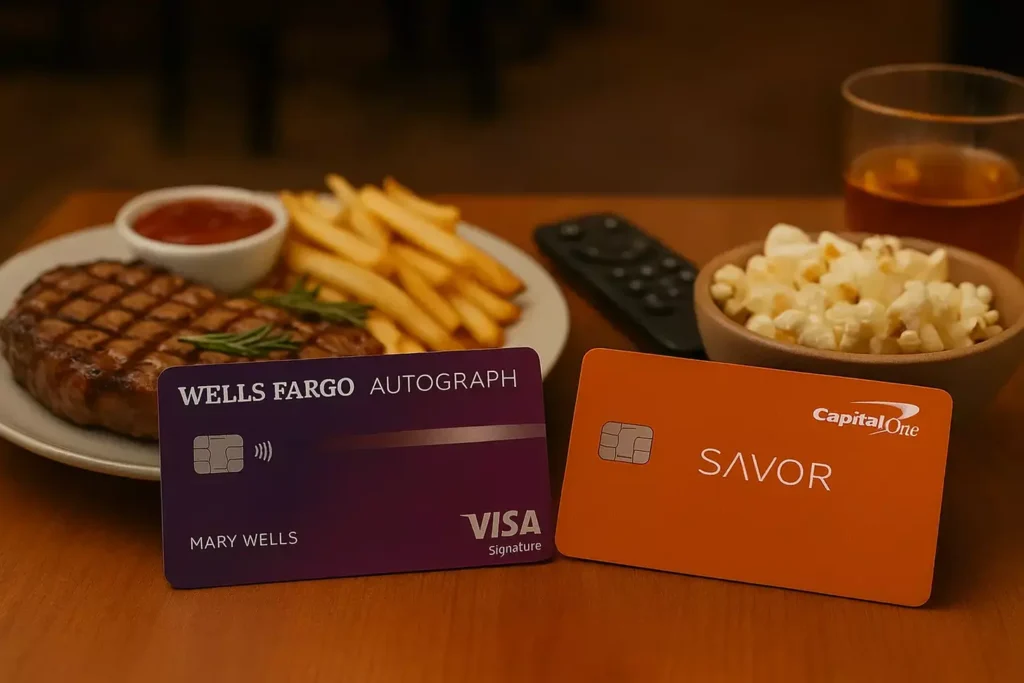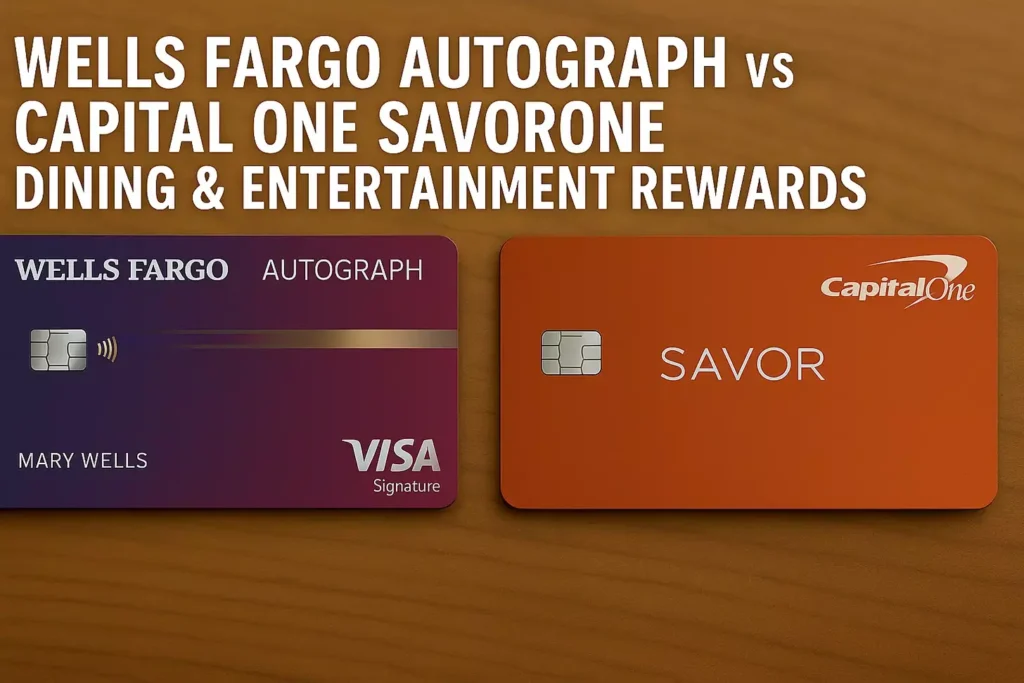Affiliate Disclosure: Award Travel Hub may earn a commission or referral bonus from some links on this site. These affiliate links help support our work and may influence the placement or promotion of certain products or services. However, our content is independently crafted to reflect honest opinions. Not all offers or products are included. There is no additional cost to users when they utilize our affiliate links.
We’ve all stood at a restaurant table wondering which card will stretch our dollars further. Choosing between these two popular options feels personal when your nights out and grocery runs matter. We’ll walk you through the details so you can pick the better fit for your routine.
Both cards carry a $0 annual fee and no foreign transaction fees, which makes either a low-cost choice. One offers 3X on restaurants, travel, gas, transit, streaming services, and phone plans plus a cell phone repair benefit with a $25 deductible. The other gives 3% cash back on dining, entertainment, streaming services, and groceries (excluding superstores), plus 5% on hotels and rental cars booked through a travel portal.
Welcome bonuses differ: one awards 20,000 points after $1,000 in purchases, while the other pays a $200 bonus after $500 in purchases. Both target applicants with good to excellent credit. We’ll compare earning rates, redemption flexibility, and extras to help you decide which card suits your spending.
Key Takeaways
- $0 annual fee and no foreign transaction fees make both accessible choices.
- Autograph’s broad 3X categories suit drivers and commuters who spend on phone plans.
- SavorOne’s 3% on groceries plus 5% portal travel perks favor mixed spenders who book hotels.
- Welcome bonuses: points versus straight cash—consider how you redeem before choosing.
- Both cards typically require good to excellent credit for approval.
At-a-glance comparison: fees, bonuses, and core earnings
At a glance, the two contenders match on cost but diverge in how they recoup your investment. Both cards carry a $0 annual fee and charge $0 foreign transaction fees, which keeps international use and day-to-day ownership inexpensive.

Annual fee, foreign transaction fees, and credit needed
Neither option adds an annual fee or foreign transaction charges, so ongoing costs stay low. Applicants should expect approval odds aligned with good to excellent credit for both cards.
Welcome offers and minimum spend: $200 value paths
Autograph nets 20,000 rewards points after $1,000 in purchases in the first three months (about a $200 value). SavorOne pays a $200 cash bonus after $500 in purchases over the same period. Both deliver similar early value, but the minimum spend differs.
Category multipliers you’ll use most often
- Autograph: 3X on restaurants, travel, gas stations, transit, streaming services, and phone plans.
- SavorOne: 3% on dining, entertainment, streaming services, and grocery stores; plus 5% on hotels and rental cars booked via One Travel.
Both cards shine on restaurants and streaming services, so your typical monthly purchases usually decide the winner.
Dining and entertainment: how each card rewards your nights out and streaming
How you split dinner, tickets, and subscription bills will shape which card delivers the best returns. We compare practical scenarios so you can match spend to the stronger earn.

Restaurants and food delivery: 3X vs 3% cash back
wells fargo autograph posts 3X on restaurants and food delivery, while capital one savor returns 3% cash back in the same category. Both cards make eating out a high-return category, so frequent diners see steady value.
Entertainment experiences: concerts, shows, movies, and Capital One Entertainment
Savor’s 3% covers concerts, shows, and movie tickets. Using capital one entertainment for eligible events can boost that return further. If you buy lots of event tickets, this card often pulls ahead.
Popular streaming services: earning at home while you binge
Both cards reward popular streaming services at elevated rates: Autograph at 3X and Savor at 3%. That makes monthly subscriptions easy, ongoing wins you’ll collect without thinking.
Grocery stores vs gas stations: which everyday spend fits you better?
One card adds 3% at grocery stores (excluding superstores), while the other gives 3X at gas stations and transit. For mixed budgets, we recommend using each card for its top categories to maximize total rewards.
Tip: Keep most purchases inside bonus categories—non-bonus spend drops to the base earn, which lowers your effective return.
Travel and transit benefits beyond dinner and a show
We weigh two approaches to travel perks so you can pick the one that fits your trips. One card gives a portal boost for hotel stays and rental cars booked through capital one travel. The other pays a steady 3X on travel, transit, and gas without forcing any booking channel.
Portal bookings that earn more
capital one travel awards 5% cash back on hotels and rental cars booked through the portal. That 5% can beat general travel rates when portal prices are competitive. Booking via one travel centralizes reservations and can simplify tracking.
Simple, consistent travel and transit earn
wells fargo autograph pays 3X on travel, transit, and gas stations with no portal requirement. That makes it easy to earn elevated rewards on airfare, trains, rideshares, and fill-ups.
- Portal wins: 5% on hotels and rental cars booked via capital one travel when pricing aligns.
- Everyday wins: 3X on transit and gas for frequent drivers and commuters.
- Both cards: $0 foreign transaction fees for international purchases and bookings.
Tip: Compare total trip cost before choosing the 5% path — portal rates vary, and direct bookings can sometimes be cheaper.
Redemption options and ecosystems: cash back, points, and portals
Redemption paths decide how far your points or cash will stretch toward a trip or everyday savings.
For straightforward value, the SavorOne-style cash back can be used as statement credits, at Amazon.com checkout, via PayPal, for gift cards, or through booked capital one channels like Capital One Travel and capital one entertainment. These options suit shoppers who want immediate, low-friction value.
Power users can convert that cash back into miles if they hold an eligible Venture or Spark Miles product. Converting at a 1:1 rate unlocks partner transfers (Aeroplan, Flying Blue, British Airways, Emirates, Etihad, Singapore), though some partners use different ratios like JetBlue (5:3).
Wells Fargo ecosystem and redemption mechanics
The other card’s points move through the wells fargo rewards portal. You can redeem for statement credits, travel bookings, merchandise, donations, or gift cards.
Practical details matter: deposits typically post in $25 (2,500 points) chunks and ATM cash redemptions come in $20 (2,000 points) increments. My Wells Fargo Deals also surfaces targeted offers to stack extra savings.
Tip: If you plan airline transfers, pair cash conversion with a Venture-family or Spark card. If you prefer steady cash, use direct statement credits or gift cards.
| Redemption Type | SavorOne-style | Wells Fargo portal |
|---|---|---|
| Instant credit | Statement credits, Amazon, PayPal | Statement credits |
| Travel tie-ins | Capital One Travel, capital one entertainment; transfer to miles via eligible cards | Travel bookings via wells fargo rewards |
| Gift options | Gift cards, Vivid Seats | Gift cards, merchandise, donations |
| Cash/ATM | Direct cash back | ATM increments: $20 (2,000 pts); deposit: $25 (2,500 pts) |
Compare portal pricing when cars booked capital or hotels are involved. Booked capital one prices can be competitive, but we recommend checking third‑party rates before committing.
Welcome offers and early value: first months with each card
The first three months are the easiest way to judge which signup bonus suits your spending. We map the timelines and tactics so you can meet the minimum spend without overspending.
Autograph: 20,000 points for $1,000 in purchases
wells fargo autograph awards 20,000 rewards points after $1,000 in purchases during the first three months. That typically equals about a 200 cash value through the issuer’s portal.
Plan a 90-day approach: combine commuting costs, phone bills, gas, and travel bookings to clear the $1,000 threshold organically.
SavorOne: $200 cash bonus after $500 in purchases
capital one savor pays a straightforward 200 cash bonus once you hit $500 in purchases in the same period. That lower hurdle gives a quicker win for many new applicants.
- Use groceries, restaurants, and streaming to meet the 500 purchases target fast.
- Time a recurring bill (phone or subscriptions) on the new card to get bonus category value and progress toward the minimum.
- Stack portal deals or targeted offers (My Wells Fargo Deals or capital one promos) to boost net value.
“Aim to meet purchases first with natural spend and pay the balance in full to avoid interest that erodes the bonus value.”
| Offer | Minimum spend | Estimated early value |
|---|---|---|
| wells fargo autograph | $1,000 in first three months | 20,000 points (~$200 cash) |
| capital one savor | $500 in first three months | $200 cash bonus |
| Common items to use | Restaurants, groceries, streaming, gas | Organic spend to hit targets |
Track points and cash accruals in each issuer’s portal so you know when the bonus posts. Align the chosen card with your normal bills to clear the threshold in the first months without extra purchases.
Perks, protections, and ongoing terms to know
Small benefits — phone coverage, rental car waivers, extended warranties — matter over time. We break down which protections kick in and how to activate them so you avoid surprises on the road or at the repair shop.
Cell phone protection and activation
Wells Fargo Autograph offers a cell phone repair or replacement benefit when you pay your monthly phone bill with the card. Coverage applies after a $25 deductible.
Set autopay to the card to ensure the cell phone protection is active and to collect the 3X category bonus.
Secondary rental car, extended warranty, and no FTFs
Capital One SavorOne includes a secondary rental car CDW waiver and extended warranty coverage on eligible purchases.
To use the rental benefit, decline the agency’s collision damage waiver at pickup. Extended warranty can lengthen manufacturer coverage for electronics bought with the card.
“Both cards carry a $0 annual fee and no foreign transaction fees, making them friendly for international spend.”
Read each issuer’s benefit guide before filing claims. Protections complement, but don’t replace, primary travel insurance when broader coverage is needed.
Wells Fargo Autograph vs Capital One SavorOne: Dining and Entertainment Rewards
We pick the card that matches where you spend most each month. Your commute, grocery runs, and nights out decide which rewards credit card returns more value.
If you dine out and drive often: leaning toward Autograph
Choose this card when you regularly fuel up, use transit, or pay phone plans with your card. The 3X categories on restaurants, gas stations, and travel create steady ways to earn rewards on routine purchases.
If you split spend between dining, grocery stores, and portal travel: leaning toward SavorOne
This card works well if grocery stores and entertainment make up a big share of your bills. It also rewards hotel stays and rental cars at 5% when booked through one travel, which boosts value for portal loyalists.
- Night out: dinner plus a concert earns well on both; the latter edges ahead on one entertainment purchases.
- At home: streaming is covered by both, so choose based on grocery stores vs gas needs.
- Household strategy: split spend—one person handles groceries and entertainment, the other covers gas, transit, and phone plans—to maximize combined earn rewards.
Tip: Base your pick on real monthly purchases, not theoretical categories you rarely use.
Conclusion
To wrap up, focus on which everyday categories you actually use most. We offer a , strong, clear takeaway: choose the card that matches real monthly habits rather than chasing theoretical bonuses.
If you drive, commute, or pay phone bills often, the 3X structure and cell phone protection are compelling. If your spend skews toward groceries, events, and portal hotel bookings, the 3% and 5% portal boosts through capital one travel can be better.
Both options share a $0 annual fee and no foreign transaction fees. Each gives roughly the same early value—20,000 rewards points after $1,000 or a 200 cash bonus after $500 in the first months—so let your purchases first decide.
Track points spend, use statement credits or gift cards when helpful, and reassess yearly as travel, streaming services, and routines change.



